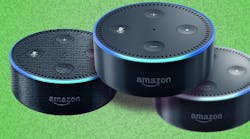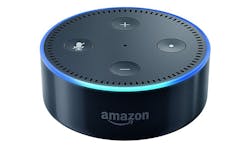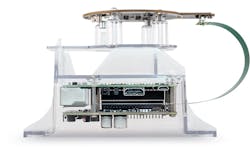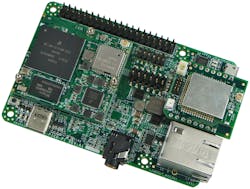Download the PDF of this article.
Voice-activated, cloud-connected, smart home control systems are all the rage, with the likes of Google and Amazon fighting for customers and application developers. These devices are available from the vendor, but it’s also possible to incorporate the technology into custom devices ranging from an Internet-of-things (IoT) refrigerator to an IoT control panel.
NXP and Amazon have partnered to deliver a reference design that integrates Amazon’s far-field voice recognition technology and software (Fig. 1). It links to Alexa Voice Service (AVS), providing the same base as used in the Echo.
1. The Amazon Echo Dot (a) is a compact version of the reference design (b).
The hardware includes Amazon’s 7-microphone array. It also uses TechNexion’s PICO series like the PICO PI and module (Fig. 2). The PICO-IMX7 is only one of a number available from TechNexion. The PICO PI accommodates all of them, allowing developers to choose the most appropriate platform based on their requirements. A lightweight system-on-chip (SoC) could be used if the voice interface is the primary use of the system, while a more powerful platform might be used when features like displays are part of the design.
2. TechNexion’s PICO PI holds a PICO-IMX7 module like the one used in the reference design.
The 36-mm by 40-mm PICO-IMX7 module has an i.MX7 Solo or i.MX7 Dual Cortex-A7 core. It also includes 802.11ac Wi-Fi and Bluetooth 4.0. There is a 4-Gbyte eMMC flash memory chip along with 2 Gbytes of DDR3L RAM. 70-pin Hirose connectors also expose MIPI CSI and DSI camera and display interfaces. There is also an RGMII gigabit Ethernet interface. Other peripheral interfaces include PCI Express, and USB, along with serial and digital interfaces. There is an I2S audio channel.
The advantage of the reference design is that it provides the same user interaction as the Echo platforms. It has already been possible to hook into AVS, but different user interfaces were used by third parties.
Vendors like Amazon and Google have a vested interest in having similar products operate in a consistent fashion. This reference design helps developers quickly turn out devices that fit this mold while providing an extensible platform. The range of NXP’s i.MX family allow developers to enhance the reference design substantially if required. For different IoT designs, check out NXP’s Android Things website.





